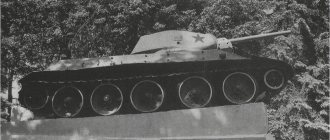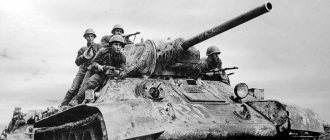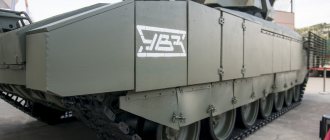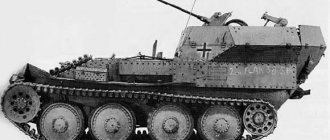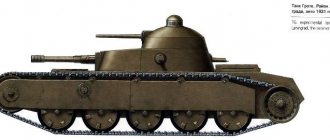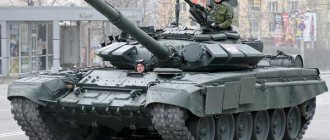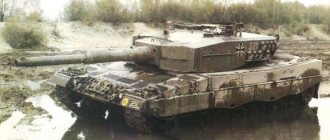"Newly built tank" Panzerkampfwagen Neubaufahrzeug
Already in the mid-twenties of the last century, Germany ceased to adhere to the terms of the Versailles Peace Treaty and began work on developing its armed forces. However, this had to be done in the strictest secrecy. This secrecy even applied to the names of the equipment: for example, tank projects were listed in documents under the name traktor. Apparently, the German leadership hoped that even if some information about the project was leaked, foreign countries would not be able to understand anything. After the Nazis came to power, non-compliance with the conditions took on even greater proportions. During the “breach of the treaty” several interesting designs were created, including the Neubaufahrzeug.
Tanks Nb.Fz. after arriving at the port of Oslo, Norway. April 1940
New project
At the end of the twenties, German engineers created several prototypes of promising heavy tanks under the general name Großtraktor. It is noteworthy that according to the classification of that time, “Grosstractors” belonged to heavy machines. By modern standards, with 15-19 tons of combat mass, they are only medium-sized. Production of all Großtraktor variants was limited to just six units. We had to tinker a lot with the prototypes of the Grosstractors, so time was lost. Already at the very beginning of the 30s, the leadership of the German army began to think about creating a new project of a similar class. In 1933, it was required to build a new heavy tank. According to the requirements of the military, the new vehicle was supposed to have a combat weight of about twenty tons, three turrets, armament from twin 75-mm and 37-mm cannons, as well as several machine guns. The technical specifications also stipulated the level of protection and driving performance. The documents used the name of the project Panzerkampfwagen Neubaufahrzeug - “Newly Built Tank”. An alternative designation is Neubaufahrzeug or Nb.Fz.
It is worth dwelling separately on the prerequisites for the requested appearance of the tank. In the early thirties, the idea of a tank as a universal combat vehicle became widespread. According to this concept, he had to fight other tanks, enemy fortifications, infantry and any type of ground equipment. Therefore, the main weaponry is Nb.Fz. it was necessary to make 75- and 37-mm guns in pairs. It was understood that two guns in one turret would allow the commander and gunner of the tank not to waste time aiming different weapons and to fire at the target with the most suitable one. In turn, two small towers with machine guns had the ability to fire at targets independently and independently of the main tower.
One of the Nb.Fz tanks. on the march. Norway, April 1940
When developing the “Newly Built Tank”, the design of the Großtraktor project in the Rheinmetall-Borsig version was first taken as the basis for the chassis. However, the large combat weight, armor requirements and a number of other aspects forced the engineers to almost completely reconsider it. As a result, the armored hull Nb.Fz. started to look like this. A steel box of complex shape, the parts of which were connected by riveting and welding. Two frontal sheets were installed at a significant angle from the vertical. A large turret box was placed in the middle part of the hull, on which, in turn, the main turret was installed. At the rear of the tank there was an engine and transmission compartment. At first, the BMW Va aircraft carburetor engine with a power of 290 horsepower was considered as an engine for the Neubaufahrzeug. However, later they decided to replace it with the Maybach HL108R, which had a power of 280 hp. In both versions of the power plant, the engine was supposed to be mounted in the center of the MTO with a slight shift to the right. This was due to the installation of a rear machine-gun turret, the shooter of which required space inside the hull.
If the housing layout is Nb.Fz. can be considered an insignificant development of the Grosstractor layout, the tracks and the track roller system have undergone much more dramatic changes. In fact, of the entire old system, only the front thrust roller remained, which prevented the front lower part of the track from deflecting. The five support bogies on board with balanced spring suspension have been newly designed. Compared to previous German tanks, such a suspension promised a much smoother ride.
The main turret of the Nb.Pz tank. was located in the middle part of the body and had a relatively large internal volume. The gunner and tank commander were located in the fighting compartment of the turret. At the same time, the latter had at his disposal a radio station (located in the rear part of the tower) and performed the work of a radio operator. Two KwK L-24 and KwK L-45 guns of 75 and 37 millimeters caliber, respectively, were placed vertically above each other - the smaller caliber gun was mounted higher. Two small turrets, similar to the turret of the PzKpfw I tank, were located at the front right and rear left. Each of them was equipped with an MG-13 machine gun. In addition, a ball mount for a third machine gun was provided in the main turret. The gunner had to fire from it.
Tests and improvements
In the same year, 1933, the project for the “Newly Built Tank” was presented to the customer. The military was satisfied with the documentation shown and ordered the construction of a prototype. Due to the state of the industry, it was decided to make the first three copies not from armor steel, but from simpler and cheaper grades. However, a number of measures were taken to ensure that all the characteristics of the experimental tank corresponded to the calculated ones. In 1934, the first experimental sample was made from “ordinary” metal. The good design of the chassis showed all its advantages during testing. A few shortcomings were identified and eliminated during testing. The main tower caused much more problems for designers, engineers and military personnel. Firstly, the vertical position of the twin guns was very inconvenient. While loading the lower 75mm cannon was more or less acceptable, working with the 37mm KwK L-45 was difficult. The breech of a more respectable gun was in the way, and in some cases the tank commander was in the way. One way or another, it was recommended to change the layout with the guns mounted vertically. The situation was no simpler with the turret machine gun. As it turns out, the gunner can either operate the cannons or fire from a machine gun. Moreover, to “switch” between weapons, the gunner had to significantly change his location in the turret. Apparently, problems with weapons alone were not enough and the Neubaufahrzeug tank “gave” its creators also problems with protection. The side hatches of the tower opened back to the side. Such hatches were used on the Grosstraktor, but with the turret design that the old armored vehicle had, during evacuation the tankers were protected by the turret and hull. On Nb.Fz. the tower had a different design, so during an emergency escape the hatches were of no use.
Repair of Neubaufahrzeug tanks in the workshop. A well-known shot that created the illusion of mass production of these machines. 1940
However, all shortcomings were taken into account and corrected. In the same year, a second unarmored prototype was built. At this stage of the project, Rheinmetall management proposed equipping the tank with one larger caliber instead of two guns. Guns with a caliber of up to 105 millimeters were considered as new weapons. A number of sources contain data on the installation of such guns on experimental and production Neubaufahrzeug. However, there is no documentary evidence of this, and in all available photographic documents, experimental and production tanks are equipped with a pair of 75- and 37-mm guns. To speed up the work, the Wehrmacht leadership decided to divide the project between the two; only the hull and chassis were made, while Krupp was engaged in the construction of the towers. Having received documents on the turret of the new tank, the latter's engineers introduced several technological changes to the design. First of all, the welded connection of the parts was replaced with a simpler bolted one. In addition, curved panels were removed from the appearance of the tower - their production was more complex and expensive, and they did not have significant advantages over straight ones. Finally, the engineers, in agreement with Rheinmetall, made characteristic bevels in the lower front part of the tower. These “cutouts” were intended to ensure that the main turret did not touch the machine gun turrets when turning. Later, this know-how will be transferred to all German medium tanks up to and including the PzKpfw IV.
Immediately before the transfer of documentation to Krupp, Rheinmetall-Borzig designers significantly changed the Nb.Fz weapon system. Two guns were now placed in a horizontal twin. This had an unfavorable effect on the pursuit of the turret - the loads during firing were uneven, but it greatly facilitated the gunner’s work. In addition, to save the gunner from having to “run” around the turret, the machine gun was rigidly mounted and its aiming was linked to the gun guidance systems. The location of the commander's workplace was also changed. Previously, he was located at the rear of the tower, but now his seat has been moved to the aft niche. In this way, it was possible to increase the free volume inside the turret and eliminate the possibility of injury to the tank commander when the guns rolled back. On the other hand, it was necessary to change the rear “armor box” of the turret and make a number of other design changes. And yet, German designers followed this path in order to avoid the need to increase the turret ring and the accompanying alterations to the hull. As for the hatches of the new turret, the side ones now began to open forward, and the commander's cupola was equipped with a double-leaf hatch. It is noteworthy that these solutions will also later migrate to new German tanks.
Tests of the updated “Newly Built Tank” showed a noticeable improvement in the performance and comfort of the crew. Now the only criticism was caused by the updated machine gun turrets - due to the new design of their roof, the machine gunners experienced some inconvenience when boarding and disembarking from the tank. However, this discomfort was considered insufficient reason for another rework. In 1935, three more Nb.Fz. units were ordered, this time they were to be fully armored. At this stage, the turret was welded again and its aft niche was changed to improve the commander's working conditions. The commander also received a new turret, and thanks to the updated shape of the rear niche, it was possible to once again increase the height of the machine gun turrets. In addition, for the first time during the Nb.Fz. project, machine gun turrets received double-leaf hatches. Now the machine gunners did not need the correct position of the main turret to enter and exit and had some kind of protection from enemy bullets. The hulls, their layout and the power plant of the three armored tanks were completely similar to the hull of the second prototype.
To battle?
At the end of 1935, tests of three armored tanks were successfully completed. The designers and workers of Rheinmetall and Krupp managed to achieve what the military wanted. But the fate of the new tank was adversely affected by the new views of the military. In 1935, the Wehrmacht leadership abandoned old views on the role of tanks in modern warfare and was in full swing developing a blitzkrieg strategy. There was simply no place for Neubaufahrzeug in the battles of the new war. But it was found in the non-combat aspects of the future World War II. The tank with three turrets and a whole range of weapons looked very harsh. Of course, the frontal armor with a thickness of only 14.5 millimeters was no longer impenetrable for modern artillery, but it was supposed to remain silent about the disadvantages of the vehicle.
Three “Newly Built Tanks” were destined to work in propaganda. All built armored Nb.Fz. were brought into a special platoon of the Pz.Abt1 battalion. Zb.V 40 under the command of Lieutenant G. Horse of the new tanks consisted of the following: arrive at the site by the end of the fighting, impressively walk through the streets of the captured city and be captured on chronicle footage. With skillful handling of photographic and film films, three tanks turned into an indestructible armada. On April 9, 1940, a special platoon departed for Norway. On the 19th, the platoon walked through the streets of Oslo, which created a rumor about the transfer of heavy tanks to Norway. With the support of J. Goebbels' department, information about “super-powerful heavy tanks” and their fictitious sky-high characteristics spread throughout the world. Soon the Norwegian resistance was broken. There is information about the participation of Neubaufahrzeug in hostilities. On April 25 of the same year, at least one Nb.Fz. participated in the attack on the village of Kvarn. Fire from English artillery Nb.Fz. was damaged and immobilized. Despite the impossibility of movement, the tank continued to support the infantry with fire. After the British retreated, the tank was evacuated and repaired. Perhaps it was this same copy of the “Newly Built Tank” that later became firmly stuck in the swamps near Lillehammer and, in order to avoid falling into the hands of the British, was blown up by its own crew.
After the end of the fighting for Norway, the two remaining tanks were returned to Germany. Next is the history of Nb.Fz armored vehicles. is a real mystery. It is known that prototypes that did not have armor were used for some time in tank schools as a teaching aid. The fate of full-fledged tanks, in turn, is not reliably known. According to some sources, all three armored Nb.Fz. were destroyed during the bombing, according to others - in 1942 they were dismantled. At the same time, in the memoirs of domestic veterans there are sometimes references to the presence of these tanks in the Eastern European theater of military operations of the Second World War. However, available documents indicate that the Neubaufahrzeug were never sent to war with the Soviet Union. One way or another, not a single copy of Nb.Fz. did not live up to this day.
Based on materials from the sites: https://army-guide.com/ https://opoccuu.com/ https://achtungpanzer.eu/ https://vadimvswar.narod.ru/
German "Traktor" in a Russian field
In the period 1926-1932, MAN, Krupp and Daimler received orders from the German government to develop prototypes of light and medium tanks, codenamed "traktor". The peculiar name was only a disguise - at that time the Treaty of Versailles directly prohibited military developments, and the Germans had to resort to tricks.
Leichte Traktor - German “light tractor” with a rotating turret
Prototypes of “tractors”, under the cover of secrecy, were tested at the Kama tank training ground ( Panzertruppenschule Kama ) located on territory in the USSR (where the hands of the “partners” at Versailles could not reach), not far from Kazan. The design of these machines was developed taking into account the lessons learned during the design of the Leichte Kampfwagen I and II (1918-1919).


